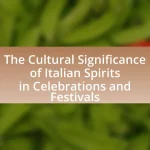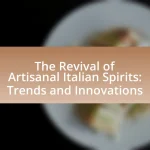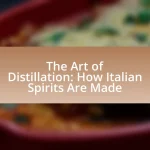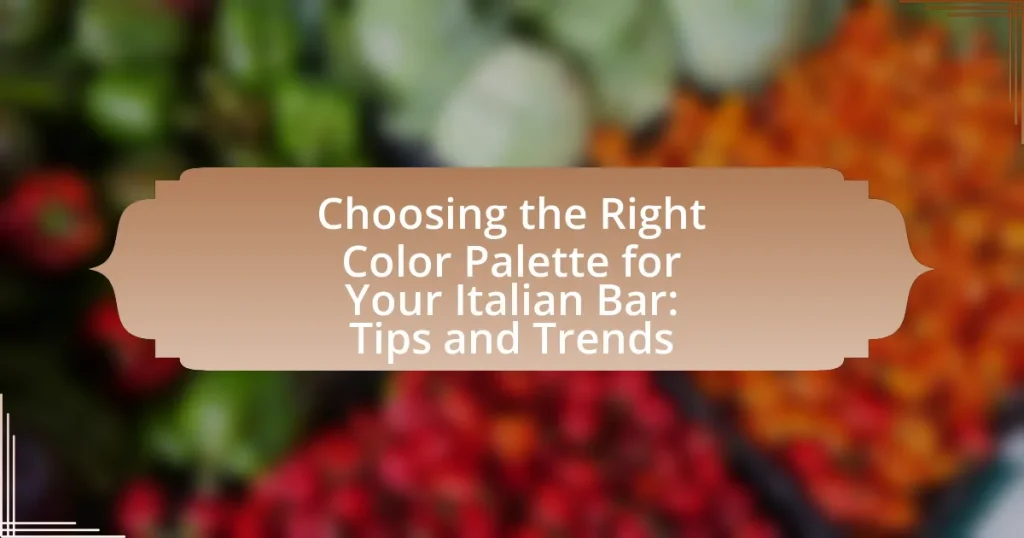Choosing the right color palette for an Italian bar is essential for influencing customer perception and enhancing their experience. The article explores how color affects atmosphere, evokes emotions, and impacts consumer behavior, emphasizing the importance of aligning color choices with cultural significance and brand identity. It discusses current trends in color palettes, the role of lighting, and best practices for applying color in interior design. Additionally, the article highlights common mistakes to avoid and practical tips for selecting an effective color scheme that resonates with the target audience while creating an inviting ambiance.
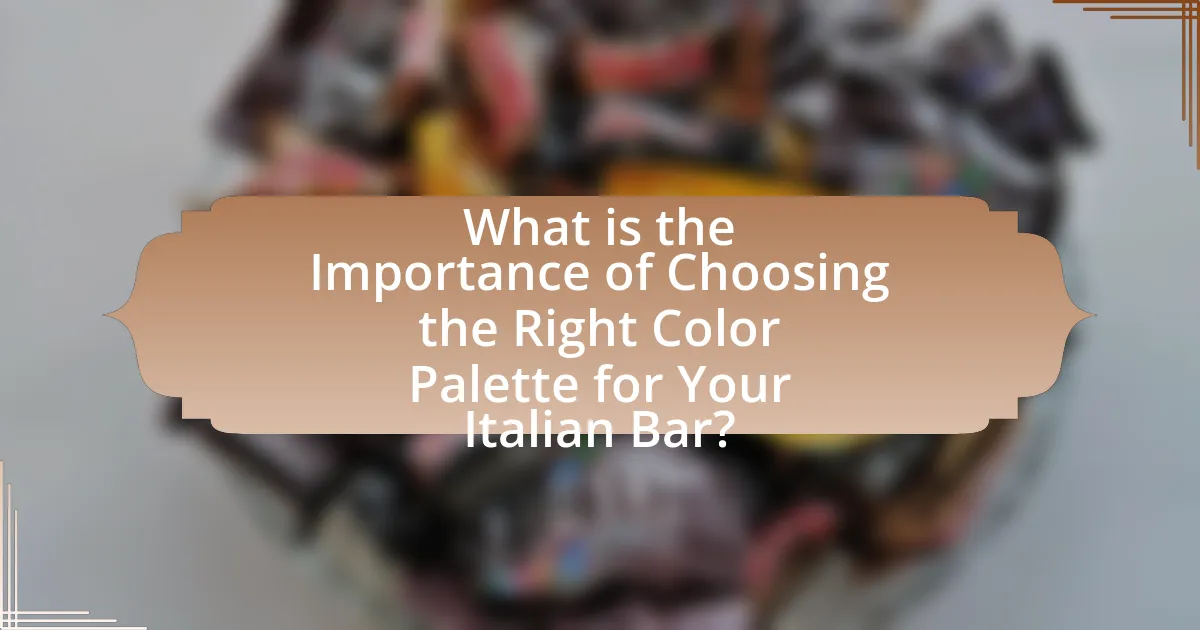
What is the Importance of Choosing the Right Color Palette for Your Italian Bar?
Choosing the right color palette for your Italian bar is crucial as it influences customer perception and experience. A well-selected color scheme can evoke emotions, enhance ambiance, and reflect the Italian culture, which is often associated with warmth and vibrancy. For instance, colors like deep reds and earthy tones can create a cozy atmosphere, encouraging patrons to linger and enjoy their time. Research indicates that color can affect consumer behavior; a study published in the journal “Color Research and Application” found that color increases brand recognition by up to 80%. Therefore, the importance of a thoughtful color palette lies in its ability to attract customers, enhance their experience, and ultimately drive sales.
How does color influence the atmosphere of an Italian bar?
Color significantly influences the atmosphere of an Italian bar by evoking specific emotions and setting the overall mood. Warm colors like red and orange create a vibrant and inviting environment, often associated with energy and sociability, which aligns with the communal dining culture in Italy. In contrast, cooler colors such as blue and green can promote a calming and relaxed atmosphere, appealing to patrons seeking a more tranquil experience. Research indicates that color psychology plays a crucial role in consumer behavior, with studies showing that 85% of consumers make purchasing decisions based on color alone. Therefore, the strategic use of color in an Italian bar not only enhances aesthetic appeal but also impacts customer experience and engagement.
What emotions do different colors evoke in a bar setting?
Different colors evoke specific emotions in a bar setting, influencing the overall atmosphere and customer experience. For instance, red stimulates excitement and passion, often encouraging social interaction and energy. Blue, on the other hand, promotes calmness and relaxation, making it suitable for a laid-back environment. Yellow evokes happiness and warmth, attracting attention and creating a cheerful ambiance. Green symbolizes tranquility and balance, contributing to a refreshing and inviting space. Lastly, purple can evoke luxury and sophistication, appealing to a more upscale clientele. These associations are supported by color psychology research, which indicates that colors can significantly impact mood and behavior in social settings.
How can color enhance the dining experience for customers?
Color can enhance the dining experience for customers by influencing their mood, appetite, and overall perception of the restaurant environment. Research indicates that warm colors like red and orange can stimulate appetite and create a sense of warmth and comfort, while cooler colors like blue can have a calming effect but may suppress appetite. A study published in the journal “Food Quality and Preference” found that color schemes significantly affect customers’ perceptions of food quality and taste. Additionally, the right color palette can reinforce a restaurant’s brand identity, making the dining experience more memorable and enjoyable for patrons.
What factors should be considered when selecting a color palette?
When selecting a color palette for an Italian bar, consider the ambiance, target audience, cultural significance, and brand identity. The ambiance influences the emotional response of patrons; warm colors like reds and yellows can create a lively atmosphere, while cooler tones may evoke calmness. Understanding the target audience helps tailor the palette to their preferences, enhancing their experience. Cultural significance is crucial, as colors can have different meanings in Italian culture; for instance, green, white, and red represent the Italian flag. Lastly, aligning the color palette with brand identity ensures consistency in messaging and visual appeal, reinforcing the bar’s theme and concept.
How does the bar’s theme affect color choices?
The bar’s theme significantly influences color choices by dictating the emotional and aesthetic atmosphere that the establishment aims to create. For instance, an Italian bar themed around rustic charm may favor warm earth tones like terracotta and olive green to evoke a cozy, inviting environment reminiscent of traditional Italian countryside settings. In contrast, a modern Italian bar might opt for sleek, minimalist colors such as black, white, and metallics to convey sophistication and contemporary style. Research indicates that color psychology plays a crucial role in consumer behavior, with specific colors eliciting particular feelings; for example, red can stimulate appetite, making it a popular choice in dining establishments. Thus, the alignment of color choices with the bar’s theme not only enhances visual appeal but also influences customer experience and engagement.
What role does the target audience play in color selection?
The target audience plays a crucial role in color selection by influencing emotional responses and brand perception. Different demographics associate specific colors with particular feelings and meanings; for instance, younger audiences may prefer vibrant colors that evoke energy, while older audiences might favor muted tones that convey sophistication. Research indicates that 85% of consumers make purchasing decisions based on color, highlighting its importance in attracting the intended clientele. Therefore, understanding the preferences and cultural associations of the target audience is essential for effective color selection in branding and design.
What are the current trends in color palettes for Italian bars?
Current trends in color palettes for Italian bars emphasize warm, earthy tones, such as terracotta, olive green, and deep reds. These colors reflect traditional Italian aesthetics and create an inviting atmosphere. Additionally, contemporary designs incorporate muted pastels and neutral shades to balance the warmth, allowing for a modern twist while maintaining a connection to Italian heritage. The use of natural materials, like wood and stone, complements these color choices, enhancing the overall ambiance and aligning with the trend of sustainability in design.
Which colors are popular in contemporary Italian bar designs?
Contemporary Italian bar designs commonly feature colors such as deep reds, rich browns, muted greens, and soft neutrals. These colors are chosen for their ability to create a warm and inviting atmosphere, which is essential in bar settings. The use of deep reds and browns often reflects traditional Italian aesthetics, while muted greens and soft neutrals provide a modern touch, aligning with current design trends that favor natural and earthy tones.
How do seasonal trends influence color choices?
Seasonal trends significantly influence color choices by dictating the palette that resonates with consumers’ emotions and preferences during specific times of the year. For instance, warm colors like reds and oranges are often favored in autumn to evoke feelings of warmth and comfort, while cool colors such as blues and greens are popular in spring and summer, reflecting the freshness and vibrancy of nature. Research from the Pantone Color Institute indicates that color trends are closely tied to cultural events, seasonal changes, and consumer behavior, demonstrating that businesses, including Italian bars, can enhance their appeal by aligning their color schemes with these seasonal trends.
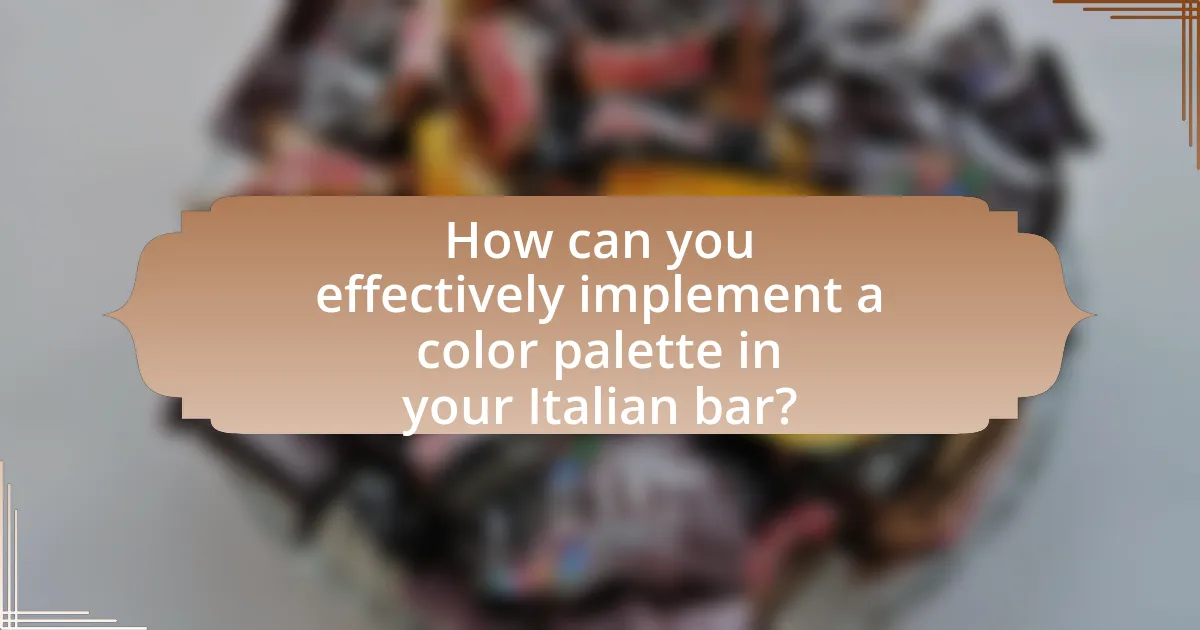
How can you effectively implement a color palette in your Italian bar?
To effectively implement a color palette in your Italian bar, select colors that reflect Italian culture and cuisine, such as warm earth tones, rich reds, and vibrant greens. These colors evoke the rustic charm of Italy and create an inviting atmosphere. For instance, using terracotta and olive green can enhance the authenticity of the space, while accents of deep red can stimulate appetite and conversation. Research indicates that color psychology plays a significant role in customer experience; warm colors can increase feelings of comfort and sociability, which are essential in a bar setting. By carefully choosing and applying these colors to walls, furniture, and decor, you can create a cohesive and appealing environment that resonates with patrons.
What are the best practices for applying color in interior design?
The best practices for applying color in interior design include understanding color theory, creating a cohesive color palette, and considering the psychological effects of colors. Color theory provides a framework for combining colors effectively, such as using complementary or analogous colors to enhance visual appeal. A cohesive color palette ensures that all elements within a space harmonize, which is crucial for creating a unified look, especially in a themed environment like an Italian bar. Additionally, colors can evoke specific emotions; for instance, warm colors like red and orange can stimulate appetite and energy, making them suitable for dining areas. Research indicates that color can influence mood and behavior, supporting the importance of thoughtful color application in design.
How can color be used to define different areas within the bar?
Color can be used to define different areas within the bar by employing distinct color schemes for each section, such as the bar counter, seating area, and lounge space. For instance, warm colors like reds and oranges can create an inviting atmosphere at the bar counter, encouraging social interaction, while cooler colors like blues and greens can be used in the seating area to promote relaxation. Research indicates that color psychology significantly influences mood and behavior; for example, a study published in the Journal of Environmental Psychology found that warm colors can stimulate appetite and conversation, making them ideal for social spaces. Thus, strategically selecting colors not only enhances aesthetic appeal but also influences customer experience and behavior within the bar.
What techniques can enhance the visual appeal of the chosen colors?
Techniques that can enhance the visual appeal of chosen colors include the use of color contrast, harmonious color combinations, and strategic placement. Color contrast, such as pairing complementary colors, creates visual interest and draws attention to specific elements. Harmonious color combinations, like analogous colors, provide a cohesive look that is pleasing to the eye. Additionally, strategic placement of colors can guide the viewer’s focus and enhance the overall aesthetic. Research indicates that effective color use can significantly impact customer perception and mood, making it essential for creating an inviting atmosphere in spaces like an Italian bar.
How can lighting affect the perception of color in your bar?
Lighting significantly affects the perception of color in a bar by altering how colors are seen and experienced. Different types of lighting, such as warm or cool tones, can enhance or diminish specific hues, impacting the overall ambiance and mood. For instance, warm lighting can make reds and yellows appear more vibrant, while cool lighting may enhance blues and greens. Studies have shown that color perception can change under various light sources; for example, incandescent bulbs tend to render colors more warmly, while fluorescent lights can create a stark, cooler effect. This variation in lighting can influence customer emotions and behaviors, ultimately affecting their experience in the bar.
What types of lighting work best with specific color palettes?
Warm white lighting works best with warm color palettes, such as reds, oranges, and yellows, as it enhances the inviting and cozy atmosphere typical of Italian bars. In contrast, cool white or daylight lighting complements cool color palettes, including blues and greens, by providing a fresh and vibrant ambiance. Studies indicate that warm lighting can increase feelings of comfort and relaxation, making it ideal for social spaces like bars. Additionally, accent lighting can be effectively used to highlight specific color features in the decor, further enhancing the overall aesthetic appeal.
How can you adjust lighting to create different moods with color?
Adjusting lighting can significantly influence the mood of a space through color. For instance, warm colors like red and orange can create an inviting and energetic atmosphere, while cooler colors such as blue and green promote calmness and relaxation. Research indicates that warm lighting enhances feelings of comfort and intimacy, making it ideal for social settings like bars. Conversely, cooler lighting can enhance focus and clarity, suitable for more subdued environments. The use of colored LED lights allows for dynamic changes in mood, as they can be adjusted to emit various hues that align with the desired ambiance.
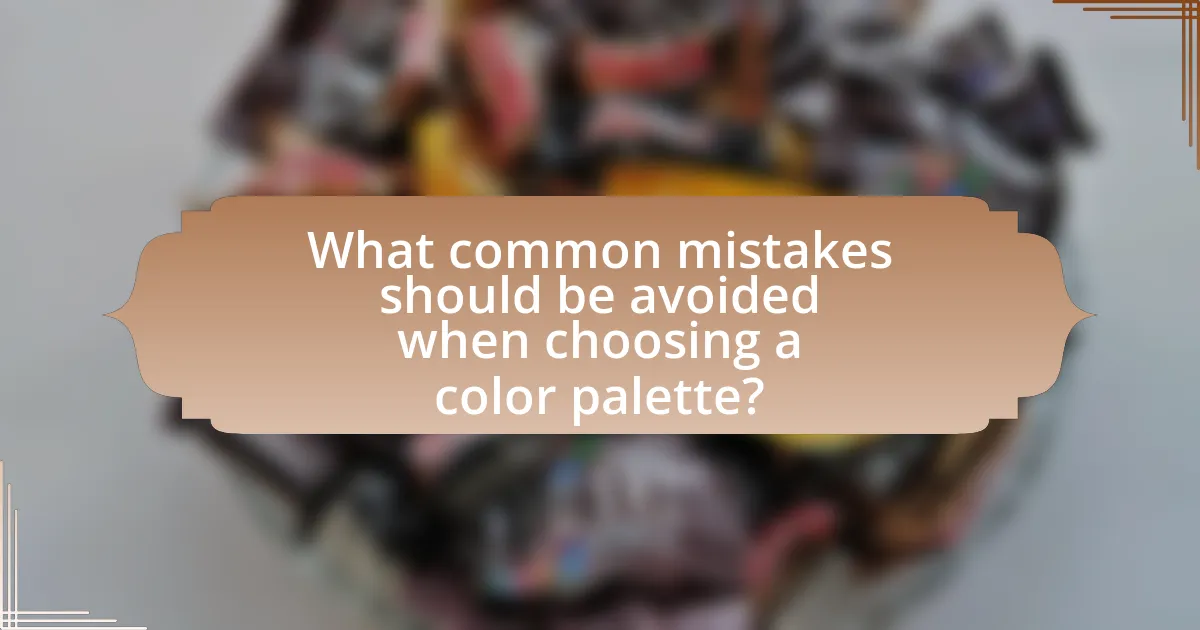
What common mistakes should be avoided when choosing a color palette?
Common mistakes to avoid when choosing a color palette include selecting too many colors, which can create visual chaos, and failing to consider the emotional impact of colors, as different hues evoke specific feelings. Additionally, neglecting the target audience’s preferences can lead to a disconnect between the bar’s atmosphere and customer expectations. Research indicates that color psychology plays a significant role in consumer behavior, with studies showing that 85% of consumers make purchasing decisions based on color alone. Therefore, ensuring a cohesive and appealing color scheme that aligns with the bar’s theme and clientele is crucial for success.
What pitfalls do bar owners often encounter with color selection?
Bar owners often encounter the pitfall of selecting colors that do not align with their brand identity or target audience. This misalignment can lead to a lack of cohesion in the overall atmosphere, making it difficult to attract and retain customers. For instance, using overly bright or clashing colors may create an uninviting environment, while muted tones might fail to convey the vibrant energy typically associated with Italian bars. Research indicates that color psychology plays a significant role in consumer behavior; for example, warm colors like red and orange can stimulate appetite and social interaction, which are crucial for bar settings. Therefore, understanding the emotional impact of color choices is essential for bar owners to create an appealing and effective ambiance.
How can overusing a color impact the overall design?
Overusing a color can lead to visual fatigue and diminish the overall effectiveness of a design. When a single color dominates a space, it can create an overwhelming atmosphere that distracts from the intended message or aesthetic. For instance, studies in color psychology indicate that excessive use of bright colors can evoke feelings of anxiety or discomfort, which may deter customers from engaging with the environment. Additionally, a lack of color variety can result in a monotonous design that fails to capture attention or convey the desired brand identity, ultimately impacting customer experience and perception.
What are the risks of following trends without considering brand identity?
Following trends without considering brand identity can lead to a disconnection between the brand and its audience, resulting in a loss of customer loyalty. When a brand adopts trends that do not align with its core values or identity, it risks confusing consumers about what the brand stands for, which can diminish trust and recognition. For example, a study by the Harvard Business Review found that brands with a clear identity are 20% more likely to retain customers compared to those that frequently shift their image. Additionally, inconsistency in branding can dilute the brand’s message, making it harder for consumers to differentiate it from competitors. This can ultimately lead to decreased market share and revenue.
What practical tips can help you choose the right color palette for your Italian bar?
To choose the right color palette for your Italian bar, focus on colors that evoke the essence of Italy, such as warm earth tones, rich reds, and vibrant greens. These colors reflect traditional Italian aesthetics and create an inviting atmosphere. For instance, terracotta and olive green can enhance the rustic charm associated with Italian culture. Additionally, consider the psychological effects of colors; warm colors like red can stimulate appetite and conversation, while cooler tones can create a calming environment. Research indicates that color can influence customer behavior, with studies showing that specific color schemes can increase dwell time and spending in hospitality settings. Therefore, selecting a palette that aligns with both cultural significance and psychological impact is essential for creating a successful Italian bar ambiance.
How can you test color combinations before finalizing your palette?
To test color combinations before finalizing your palette, utilize digital design tools like Adobe Color or Canva, which allow you to visualize and adjust color schemes in real-time. These platforms provide features such as color harmony rules and the ability to see how colors interact with each other, ensuring that the selected combinations evoke the desired atmosphere for your Italian bar. Research indicates that color perception can significantly influence customer emotions and behaviors, making it essential to test combinations effectively.
What resources are available for inspiration and guidance in color selection?
Resources available for inspiration and guidance in color selection include color theory websites, design blogs, and color palette generators. Websites like Adobe Color and Coolors provide tools for creating and exploring color schemes based on various themes and trends. Design blogs often showcase successful projects and color combinations, offering visual examples and expert insights. Additionally, platforms like Pinterest and Instagram serve as visual inspiration hubs, where users can discover color palettes used in real-world applications, particularly in the hospitality industry. These resources collectively support informed decision-making in selecting color palettes for spaces like Italian bars.
